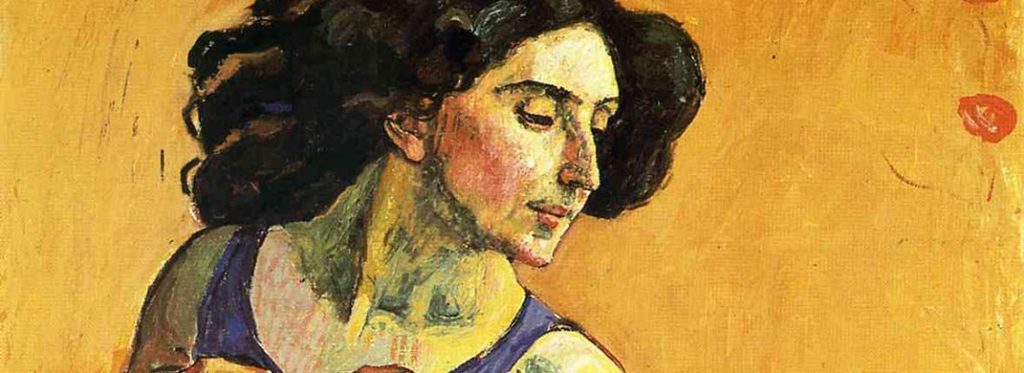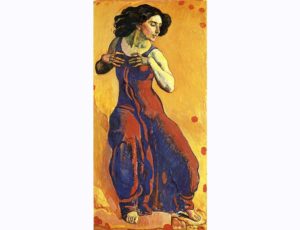Holiday Arts Preview: Visual
By • November 22, 2017 0 716

If you’re not leaving town for the holidays, December is the perfect month to visit Washington museums. Warm, spacious havens from the claustrophobic chill of winter —
and a half-decent excuse to escape visiting relatives for the afternoon — art museums can often be surprisingly quiet as Christmas approaches. While others are distracted
by their trips and travels, you can be wandering wistfully through a modern palace packed with paintings.
Drawn to Purpose: American Women Illustrators and Cartoonists through Oct. 20
“Drawn to Purpose: American Women Illustrators and Cartoonists” addresses evolving ideals of feminine beauty, emerging opportunities for women in society, changes in gender relations and issues of human welfare. Spanning the late 19th century to the present, the exhibition will feature nearly 70 works by 43 artists in two rotations, including Grace Drayton’s wide-eyed, red-cheeked Campbell Kids; Lynn Johnston’s comic strip “For Better or For Worse”; Persian Gulf War editorial illustrations by Sue Coe and Frances Jetter; “Mixed Marriage” by New Yorker cartoonist Roz Chast; and work by graphic novelist Raina Telgemeier.
HIRSHHORN
Mark Bradford: Pickett’s Charge through Nov. 12
Nearly 400 linear feet in length, “Pickett’s Charge” is Mark Bradford’s first solo exhibition in Washington, D.C., and his first major American solo show following his presentation as the U.S. representative for the 57th Venice Biennale. Bradford (b. 1961) drew inspiration for this new work from French artist Paul Philippoteaux’s 19th-century Gettysburg cyclorama. Working with a combination of colored paper and reproductions of the original, the artist cut, tore and scraped through their layers to transform the historic imagery into a series of eight powerful abstract paintings encircling the Hirshhorn’s third-level galleries.
FREER/SACKLER
Divine Felines: Cats of Ancient Egypt through Jan. 15
Cats’ personalities have made them Internet stars today. In ancient Egypt, cats were associated with divinities, as revealed in “Divine Felines: Cats of Ancient Egypt.” Cat
coffins and representations of the cat-headed goddess Bastet are among the extraordinary
objects that reveal felines’ critical role in ancient Egyptian religious, social and political
life. Dating from the Middle Kingdom to the Byzantine period, the more than 80 works
include statues, amulets and other luxury items decorated with feline features.
In the Tower: Anne Truitt through April 1
One of the leading figures associated with minimalism, Anne Truitt (1921-2004) lived and worked for almost her entire career in Washington, D.C., maintaining a succession of studios when affordable space was still available to artists. This exhibition, a survey of Truitt’s sculpture, painting and works on paper, traces the career of an artist who developed her work quietly and independently in the former carriage and row houses of this city. Note: An extended story about Truitt will appear in an upcoming issue of The Georgetowner.

“Mural,” 1943. Jackson Pollock. Courtesy National Gallery of Art.
Jackson Pollock’s ”Mural” through Oct. 28
This special installation in the National Gallery’s East Building focuses on Jackson Pollock’s “Mural,” nearly 20 feet long, on loan from the University of Iowa Museum of Art. Originally commissioned by Peggy Guggenheim for her New York City townhouse, the 1943 painting, Pollock’s largest work, represents a major turning point in the artist’s career and style. Also on view are paintings and works on paper by Pollock from the National Gallery’s collection.
SMITHSONIAN AMERICAN ART MUSEUM
Kara Walker: Harper’s Pictorial History of the Civil War (Annotated) through March 11
For more than two decades, Kara Walker (b. 1969) has been making work that weaves together imagery from the antebellum South, the brutality of slavery and racist stereotypes. Tseries of 15 prints based on the two-volume anthology published in 1866. To create her prints, Walker enlarged select illustrations and overlaid them with stenciled figures. The shadowy images disrupt the original scenes and suffuse them with traumatic scenarios and mangled, grotesque figures. In the exhibition, Walker’s prints are presented alongside a selection of the original Harper’s images.
Tamayo: The New York Years through March 18
“Tamayo: The New York Years” is the first exhibition to explore the influences between
Mexican modernist Rufino Tamayo (1899-1991) and the American art world. Tamayo — whose lushly colored paintings of Mexican subjects earned him widespread acclaim — was drawn to New York City in the early 20th century at a time when unparalleled cross-cultural
exchange was taking place. This exhibition reveals how he forged a new path in the modern art of the Americas and contributed to New York’s dynamic cultural scene as the city was becoming a center of postwar art.
NATIONAL SPORTING LIBRARY & MUSEUM
The Horse in Ancient Greek Art through Jan. 14
As symbols of wealth, power and status, horses — both mythical and real — appear on the finest examples of ancient Greek art and pottery. Vase paintings depict chariot horses being harnessed, jockeys riding and grooms tending to well-bred steeds. “The Horse in Ancient Greek Art,” a major loan exhibition at the National Sporting Library & Museum in Middleburg, Virginia, displays black- and red-figure vases, sculpture and coins from the 8th through the 4th centuries B.C., investigating how equine imagery was used in myth, war, sport and competition and exploring the significance of the horse in ancient Greek culture.

Femme en Extase (Woman in Ecstasy) [detail]/ Ferdinand Hodler / 1911, Oil on canvas laid down on wood / Ville de Genève, Musées d’art et d’histoire
“Portraits of the World: Switzerland” is the inaugural exhibition of a series highlighting American portraiture’s global context. Each year, the National Portrait Gallery will showcase
a portrait created by an artist affiliated with the lending country. The first work, on loan
from Geneva’s Museum of Art and History, is “Femme en extase” (“Woman in Ecstacy”),
a portrait of Italian dancer Giulia Leonardi by Swiss painter Ferdinand Hodler (1853-
1918). Embodying eurhythmics, the Swiss modernist approach to expressing emotion
through movements of the body, “Femme en extase” will be complemented by works from
the Portrait Gallery’s collection representing American dancers influenced by eurhythmics.


